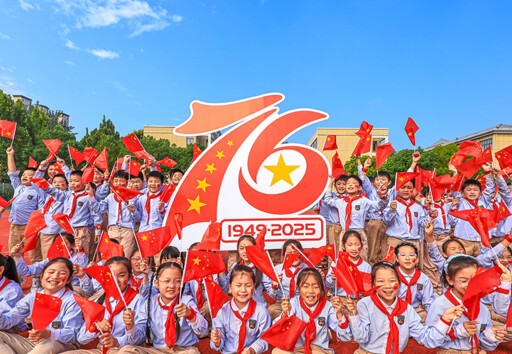


National history studies trace extraordinary journey of PRC 76 yrs on

Students pose for a photo with the panel designed to celebrate the 76th anniversary of the PRC at a school in Suqian, Jiangsu Province, on Sept. 30. Photo: IC PHOTO
On Oct. 1, the People’s Republic of China (PRC) celebrated its 76th anniversary. As dedicated chroniclers and rational analysts of new China’s construction and development, scholars engaged in national history research have relied on rigorous academic perspectives and scientific methods to explore the underlying logic of the nation’s progress. By distilling valuable historical experience, they have provided intellectual support and historical insight for the country’s new journey. Recently, CSST interviewed several scholars in this field to hear how the study of national history has advanced in tandem with the PRC’s development.
Epic of confidence, miracles
Scholars concurred that the PRC’s 76-year history is an epic of confident struggle and miraculous achievements.
From an impoverished nation to the world’s second-largest economy, from isolation and backwardness to openness, and from chronic scarcity to moderate prosperity, new China’s 76-year journey has been marked by the continual creation of miracles in the face of numerous risks and challenges.
“The PRC’s history is one of continuous evolution and development,” said Song Yuehong, deputy director general of the Institute of Contemporary China Studies at the Chinese Academy of Social Sciences and vice president of the Association of the National History of the People’s Republic of China. With over two decades of experience in national history research, Song outlined for CSST the principal stages of new China’s development: the period of socialist revolution and construction laid the fundamental political and institutional foundations; the new period of reform and opening up alongside socialist modernization opened the path of socialism with Chinese characteristics; and the new era of socialism with Chinese characteristics achieved the historic milestone of building a moderately prosperous society in all respects, launching a new journey toward building a modern socialist country.
Song noted that in-depth study of national history has led him to a profound understanding of the decisive significance of the “Two Establishments”—the establishment of Xi Jinping’s core position on the CPC Central Committee and in the Party as a whole and the establishment of the guiding role of Xi Jinping Thought on Socialism with Chinese Characteristics for a New Era—and the great value of the “Two Integrations,” which integrate the basic tenets of Marxism with China’s specific realities and fine traditional culture. The guidance of Marxist scientific theory, he emphasized, is the fundamental basis by which the CPC maintains its historical initiative and steadfast direction.
Continuously updated research
Over the past 76 years, China has experienced remarkable progress across all sectors: sustained and steady economic development, a significant rise in composite national strength, rapid advances in science and technology, and continuous improvement of people’s wellbeing. As a mirror reflecting the transformations of the times, the study of national history has evolved in step with the PRC’s advancement.
Reviewing the development of national history research, Zhao Chaofeng, a professor from the School of Marxism at Beijing Normal University, divided its progression into several key phases. In the initial stage, works such as Hu Qiaomu’s Thirty Years of the Communist Party of China and Liao Gailong’s A Brief History of the Chinese People’s War of Liberation and the First Five Years of New China laid the preliminary groundwork. With the adoption of the Resolution on Certain Questions in Our Party’s History Since the Founding of the PRC in 1981, the field ushered in a new phase, delving deeper into research guided by the spirit of the resolution. During the new period of reform and opening up, major publications like the Contemporary China series and The History of the People’s Republic of China fostered a basic consensus in the discipline’s theoretical development.
“Entering the new era, the study of national history has made significant progress under the guidance of Xi Jinping Thought on Socialism with Chinese Characteristics for a New Era,” Zhao emphasized. The Resolution on the Major Achievements and Historical Experience of the Party over the Past Century, adopted at the Sixth Plenary Session of the 19th CPC Central Committee in 2021, has provided fundamental guidance for national history research. The in-depth implementation of the campaign to study the histories of the CPC, of the PRC, of reform and opening up, and of socialist development—known collectively as the “Four Histories”—has propelled the compilation of teaching materials such as A Brief History of the People’s Republic of China and The Decade of the New Era, making “great transformations in the new era” a focal point of research and spurring the flourishing of thematic and specialized historical studies.
The historic achievement of comprehensively deepening reform in the new era has also opened new horizons for national history research. Chen Dacai, a professor from the School of Marxism at Shaanxi Normal University, stated that the 20th CPC National Congress has outlined a grand blueprint for advancing national rejuvenation on all fronts through a Chinese path to modernization. He stressed that Chinese modernization, the crystallization of more than 70 years of exploration since the founding of the PRC, is grounded in China’s national conditions, draws on global experience, and demonstrates distinctive Chinese wisdom.
Wang Ruifang, a distinguished professor at Henan University, added that the practice of comprehensively deepening reform provides multiple new perspectives for national history research. These include tracing the trajectory of national development through the lens of “institutional evolution,” analyzing the interconnections and interactions of various reforms from the perspectives of “systematicness, hoisticness, and synergy,” examining the reshaping of relations among the state, society, and market through the dimension of “governance modernization,” and observing the evolution of China’s relationship with the world through “international comparison.”
Editor:Yu Hui
Copyright©2023 CSSN All Rights Reserved